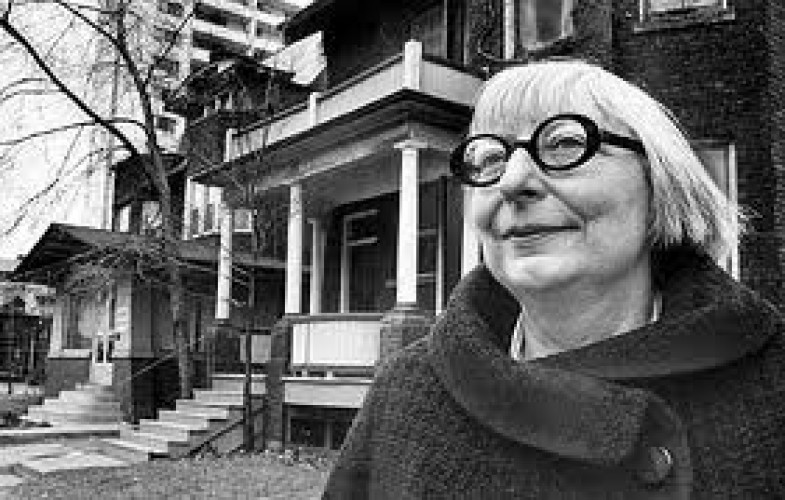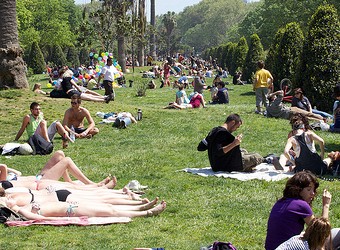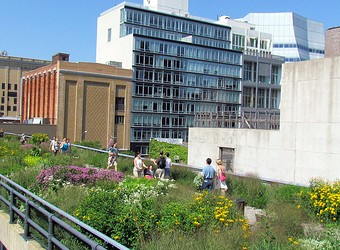Not many people have the imagination, intellectual depth and sheer courage to take on an entire profession and demonstrate how it is wrong. Jane Jacobs did. The renegade author and activist — who died in 2006 at age 89 — not only took on many such “impossible” challenges, she often prevailed. In her devotion to humanistic, small-scale solutions to big problems, Jacobs can be rightly understood as an early champion of what we now call the commons.
Jacobs’ landmark 1961 book, The Death and Life of Great American Cities, offered a damning critique of modern urban planning and the socially destructive effects of knocking down wide swaths of our cities to construct freeways and high-rises, which at that time was hailed as “urban renewal”. She championed just the opposite: vital urban neighborhood with street life, businesses mixed with housing, short blocks, a variety of building styles and heights, and density. This “radical” view about how to make communities safe and appealing, based on simple common sense, spurred a new appreciation for classic neighborhoods that eventually curtailed the wanton bulldozing of our cities, boosted the historical preservation movement and inspired the neighborhood revitalization efforts that are bolstering many places today. Activists and planners today who favor smaller-scale, mixed-use neighborhoods that foster social interaction trace a direct lineage to Jacobs.
An Insightful, Visionary, Powerful Amateur
Jacobs never finished college and was not trained as an urban planner. She was a committed amateur. This is a key reason why her work was so insightful. She was not entangled in the deeply rooted assumptions and habits of the profession.
That’s what made Jacobs’ vision so powerful: it was informed by a rich sense of humanity and real world experience, not by ideological abstractions. In The Death and Life of Great American Cities, she wrote: “There is a wistful myth that if only we had enough money to spend—the figure is usually put at $100 billion—we could wipe out all our slums in 10 years…But look at what we have built with the first several billions: Low-income projects that became worse centers of delinquency, vandalism, and general social hopelessness than the slums they were supposed to replace. Middle-income housing projects which are truly marvels of dullness and regimentation, sealed against any buoyancy and or vitality of city life.”
Jacobs understood that community is not as an abstract design principle; it’s an everyday experience. Community is not rational and orderly, but dynamic and relational.
An Early Champion of Small Is Beautiful
She was subversive because she recognized that power often resides in unexpected places. In the conformist Fifties, Jacobs saw diversity as a source of strength. At a time when the male-dominated profession of urban planning favored huge megaprojects, Jacobs realized that important things occur in small-scale social settings. In her later years, Jacobs challenged the abstract, quantitative focus of the economics profession and insisted upon the importance of morality in the behavior of markets.
Jane Jacobs was a pioneer in developing ideas that are central to the commons today: informal social norms, the bottom-up dynamics of change, the power of diversity, the limits of professionalism and officialdom. What thrills me about Jane Jacobs was not just her deep insights, but her fierce passion to advance her ideas. She once got arrested for disrupting a public meeting about building a freeway near her neighborhood of Greenwich Village in New York City. “We had been ladies and gentlemen and only got pushed around,” she said. Let us remember a great champion of the commons who refused to get pushed around.
David Bollier thinks and writes about the commons at www.Bollier.org, where this post originally appeared under a Creative Commons Attribution license. Bollier’s commons activism is focused on the Commons Strategy Group and the The Commons Law Project. He is co-author (with Burns H. Weston) of the just-published book Green Governance: Ecological Survival, Human Rights, and the Law of the Commons (Cambridge University Press).







